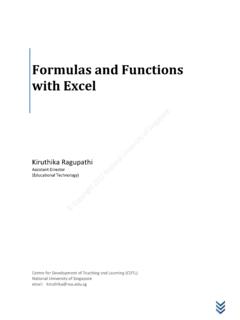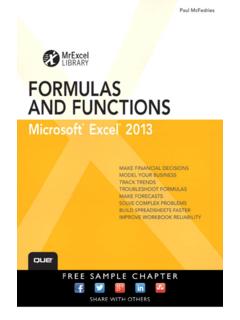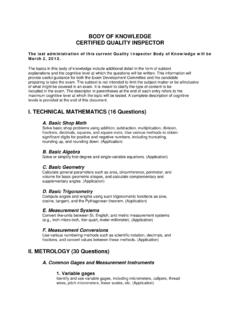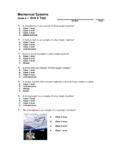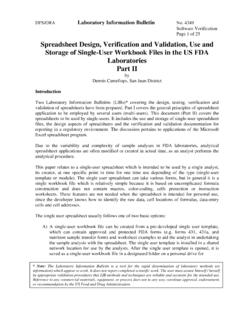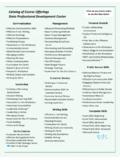Transcription of RF-Microwaves formulas - 1-port systems - Pilloud
1 RF-Microwaves formulas - 1-port systemss-parameters:Considering a voltage source feeding into the DUT with a source impedance of Z0. The voltage into the DUT is composed of 2 parts, an incident wave Ei1 and a reflected one Er1 characterized by voltage and current :(1)Noting that the DUT is connected to the source by a length of transmission line of characteris-tic impedance Z0 (possibly vanishingly small as in the example above), the voltage along the line is the sum of the 2 waves (V1) while the current, because the waves are travelling in oppo-site direction is the difference of the 2 waves, divided by Z0. This is further described in the Appendix at the end of this defining the following normalized notation:(2)a1 and b1 become the square root of the forward and reflected powers. Note thus that the square of a1 and b1 have the dimension of power. We can write a function s11 such that:(3)relating these 2 voltage waves and s11 is:(4)Input impedance:The input impedance can be expressed either as a rectangular value (ZL = R + jX with R being the real part of ZL and X the imaginary part of ZL) or as a polar value (ZL = M here M is the magnitude of ZL and P its phase angle) :(5)Z0 DUTEi1Er1V1Ei1Er1+=I1Ei1Er1 Z0---------------------=a1Ei1Z0--------- -=b1Er1Z0----------=b1s11a1=s11b1a1----- =P ZL1s11+1s11 ----------------Z0 =Reflection coefficient:(6)The reflection coefficient gamma represents the quality of the impedance match between the source and the measured load.
2 It is a complex quantity, with magnitude rho and angle reflection coefficient is small for good matches. The reflection coefficient takes values from 1 for shorts, stays negative for loads < Z0, is zero for perfect matches, is positive for loads > Z0, and reaches +1 for open normalized impedances:and (7)From equ.(5), it follows that s11 is:(8)Here we see that s11 and (the reflection coefficient) are one and the Loss:Considering the reflection coefficient as:(9)the Return Loss (expressed in dB) makes use of to be:(10)The higher the absolute value of the Return Loss, the better the match. The Return Loss is a measure of the power that is not absorbed by the load and is therefore returned to the source. So large absolute values of the Return Loss ( : > |20| dB) imply a good :Just as for the Return Loss, the VSWR (dimensionless) is calculated from :(11)The VSWR is useful to estimate (calculate) the peak voltage that can be found on a line under non-ideal match conditions.
3 It is also an common measure of the goodness of a match. A perfect match is characterized by a VSWR of 1, while a short or open circuit produces a VSWR of . ZLZ0 ZLZ0+------------------Y0YL Y0YL+------------------=== Z1 Z1+------------1Y 1Y+------------== =Z1 +1 -------------=s11Z1 Z1+------------ == =Lr201 --- log20 ()log ==VSWR1 +1 ------------1s11+1s11 -------------------== Charts and Smith chart :There are three types of charts commonly used to represent complex values in RF work. The Rectangular chart is used for rectangular values (R + jX), the Polar chart for polar values (M) and the Smith chart for both of these, and S-parameters also (and a many other values too). One interesting observation is that with normalized parameters, all 3 charts can be overlaid, as shown on the 3 figures above, and the same vector can be read in several manners off their respective axes. On a Smith chart , one plots normalized impedances if referring to the curved axes, it is also possible with a protractor and a ruler to enter s-parameters as magnitude and angle, as would be done on the polar plot.
4 The complete smith chart has an angle scale all around it for that purpose, and at the bottom of the chart , there usually is a graduated scale of the same diameter as the chart , on which it is possible to report and read the polar magnitude of the :For the series circuit of L = nH and R = at 1 get : Z = + , normalized to 50 : Zn= + S11 which is equal to : (12)P RectangularPolarSmith( , ) + S11 Zn1 Zn1+ + ====Other quantities of interest:(13)(14)These values have been identified on the three graphs :Let s consider 3 obvious cases of a segment of transmission line, either properly terminated, or open or shorted, and let s apply equ.(1) at point A, at the end of the transmission line, noting that the transmission line can be any length, included none. Line properly terminated: Note that either schematic can be used for the following action sets the voltage at A at: VOhm s law says that IA is: mAWe know that in a properly matched system there will be a forward wave but no reflected wave.
5 So according to equ.(1) at point A:(15)Shorted line: By inspection the voltage at point A is zero and the current is: know that in a shorted line, there will be a forward wave and a reflected one but with reverse polarity. So according to equ.(1) at point A:(16)VSWR1 +1 +1 --- dB==1 0 1 0 50 50 50 50 50 0 10 100----------100 = 0 0+ 0 V == 0 0 50------------------------10 0 mA ==1 0 1 0 50 50 50 AA10 50----------200 = 0 0 0 V== 0 0 () 50-------------------------------------- -------20 mA==Opened line: By inspection the voltage at point A is V and the current know that in an opened line, there will be a forward wave and a reflected one of the same polarity. So according to equ.(1) at point A:(17)Note: One last question might be: why did we choose a value of V for the forward and reflected waves? Well simply because it is the only value that fits all cases, but there is a better and simpler answer; in the matched case, where there is no reflection, this is the value pre-dicted for the forward wave by Ohm s law and by the maximum power transfer : Une version en Fran ais de cet article est disponible sur :http://www/ Pilloud /net/op_ #05 Olivier Pilloud - HB9 CEM - 2005-06-281 0 1 0 50 50 50 AA10 0 0 +10 V == 0 0 50------------------------------------0= =

